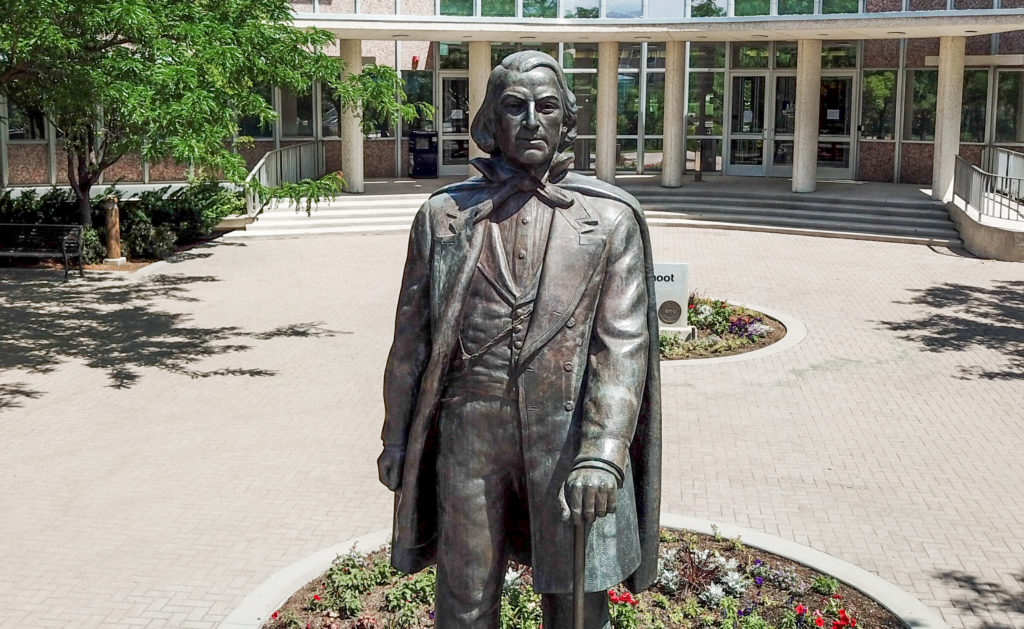Read en español: La historia y memoria: la comunidad de BYU lucha con nombres y monumentos

Protests against racism across the country have sparked discussions about removing statues and renaming buildings that memorialize historic figures who made racist comments, and BYU is not immune to these calls.
These discussions, however, are sometimes more complicated than simply calling for the removal of statues since past leaders are complex people.
Call for ‘unnaming‘
Members of BYU’s Black Student Union wrote two letters — one to the NAACP, the other to President Russell M. Nelson — asking for all buildings on the BYU campus to be “unnamed” and have all the names removed, not just the names of those associated with slavery and racism.
“If there’s not going to be any buildings named after women, after people of color, let’s take all the names down because we’re still glorifying a certain kind of figure on campus,” outgoing BYU BSU President Deborah Alexis said. “A lot of these figures had problematic ideologies that have lasting consequences today.”
Author Don Izekor said the letters are a call to action after leaders have spoken about change but failed to act. He hopes that by writing to the NAACP, the organization will help push the Church to make changes because of their relationship.
“All that we ask is that Brigham Young University recognizes that we, too, have the right to claim this space and that it is hard to do so with relics that myopically glorify a shameful past,” says the letter to President Nelson.
Others argue that the names shouldn’t be changed when those memorialized also did good things for the school.
Quotes from some of Brigham Young’s speeches during the time he led the Church have resurfaced amid these conversations. In many instances, he referred to Black people as descendants of Cain, who was cursed for killing his brother Abel in the Old Testament.
“Shall I tell you the law of God in regard to the African race? If the white man who belongs to the chosen seed mixes his blood with the seed of Cain, the penalty, under the law of God, is death,” Brigham Young said as recorded in the Journal of Discourses.
In an op-ed for the Salt Lake Tribune, BYU student Hanna Seariac wrote in opposition to changing the name of the university in light things the record says Brigham Young said.
“Removing historical figures from their contexts and evaluating against our standards is unfair to them,” says Seariac in her op-ed. “We should point out what (Brigham Young) did wrong, but we should at the same time remember the valuable contributions that he had.”
As of July 14, BYU has not made a statement in response to these calls for renaming. The Black Student Union also said it has not received any responses to its letters besides an acknowledgment from the NAACP that it received the letter.
Historians’ perspectives
According to BYU history professor Matthew Mason, current standards on racism and slavery come from the 18th and 19th centuries when people were developing religious, anti-slavery points of view and the principles of the Enlightenment that said all people were created equal.
He said the best way to analyze the historic leaders like Brigham Young “is to look at the choices available in the middle of the debates they were in and the ideas available to them, which in the case of questions of race and slavery are really no different than the ideas we have today because that’s where we got them.”
When it comes to statues and names of buildings, Mason said there’s a difference between history and memory: History is complex and examines what happened in the past, but memory is emotional and focuses on how the past is commemorated today.
“The debates about how to remember the Civil War or Brigham Young or whatever right now tell us more about 2020 than they do about 1847 or 1861,” Mason said. “Therefore the way things like building names and monuments get addressed tends to be emotional because it’s about our current identity and our current values.”
BYU history professor Christopher Jones said it is important for those who study history to acknowledge the historical context of the time periods people lived in, but “we should be more than willing to condemn racism when we encounter it in the past.”
“Simply because there were people that were more pro-slavery in the 19th century than there are in the 21st century doesn’t somehow make slavery OK in either time period,” he said. Jones also pointed out that there were many who were anti-slavery in the 19th century as well.
According to Jones, people sometimes avoid complicated, difficult discussions when they excuse past racism by arguing that present standards shouldn’t apply to historical figures or only focus on the good actions and qualities of leaders.
However, Jones said it is important to study history and have those discussions. “I hope that we can open up space to have those difficult conversations so that we can come to a better understanding not just of history but of its legacies today and in the present.”




